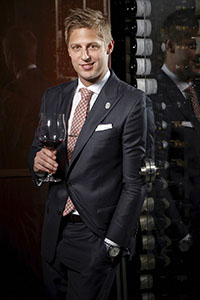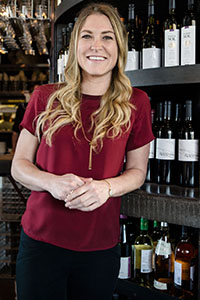When guests walk into a restaurant or bar, they’re met with a cascade of sights and sounds. The music, the lighting, the decor, and the proverbial “buzz” that the space emits all immediately flood the senses and give an impression of the experience to come. And while that first moment is formative, it’s really what’s happening behind the scenes that truly shapes the guest experience.
Consider it the invisible hand of organization, the unseen backbone that supports everything, and the engine that drives the ship. At the heart of every department in the restaurant, from the front of the house to the back, from the coffee station to the wine cellar, those with the highest standards of organized systems are those that will thrive. And operators are increasingly making use of cloud-based technology to support those systems.
 “Organization is generally what makes a business profitable,” said Lenny Rede, a former chef who spent 20 years in restaurants and is now the wine and spirits buyer for New Seasons Market in Seattle. “Organization is a discipline. Having a system of managing your product that is easy for your staff, and even customers, to understand will create efficiencies in terms of labor, but also purchasing and receiving. Many staff members miss potential sales because they don’t know what they have on the shelf. If you don’t know what you have, then you don’t know what is selling, and you’ll never increase sales.”
“Organization is generally what makes a business profitable,” said Lenny Rede, a former chef who spent 20 years in restaurants and is now the wine and spirits buyer for New Seasons Market in Seattle. “Organization is a discipline. Having a system of managing your product that is easy for your staff, and even customers, to understand will create efficiencies in terms of labor, but also purchasing and receiving. Many staff members miss potential sales because they don’t know what they have on the shelf. If you don’t know what you have, then you don’t know what is selling, and you’ll never increase sales.”
Katelyn Peil has been the beverage director for Heavy Restaurant Group in Washington State for 12 years, and oversees multiple locations.
“Sales and profits are absolutely connected to overall organization, particularly for beverage programs,” she said. “Not having your team set up for success leads to a slowdown in service. When someone has to search high and low for a particular bottle of something, that is taking away from the guest’s dining experience and leads to missed opportunities. With a wine list of about 300 bottle selections and 80 wines by the glass, the physical organization of the restaurant is key. I organize all of our storage the same way that our wine list reads. We have separate areas for our glass pours, separated by white, red, etc., and I’ve created an excel spreadsheet map that has all the bottles listed and where they should live. I laminate that and change it every time my list changes so the bar team, or anyone for that matter, can jump in and know exactly where to look for that particular bottle.”
Organization, preparedness and having foresight starts with management, but everyone must be onboard and trained to maintain the standards.
 “Training certainly takes time,” said Chris McFall, sommelier at Lazy Bear in San Francisco. “We are trying to improve these systems daily, and this takes a team effort. Trust your colleagues, but verify accuracy. Keeping the cellar neat and tidy, as well as having an accurate inventory is key. From top to bottom, profits are connected to [organization], and this can be done with astute attention to detail and organization, as well as with set rules and regulations. Example: Once a case is opened, the wines must be binned and a location must be found, and nothing can touch the floor. And always use the ‘first in, first out,’ golden rule.”
“Training certainly takes time,” said Chris McFall, sommelier at Lazy Bear in San Francisco. “We are trying to improve these systems daily, and this takes a team effort. Trust your colleagues, but verify accuracy. Keeping the cellar neat and tidy, as well as having an accurate inventory is key. From top to bottom, profits are connected to [organization], and this can be done with astute attention to detail and organization, as well as with set rules and regulations. Example: Once a case is opened, the wines must be binned and a location must be found, and nothing can touch the floor. And always use the ‘first in, first out,’ golden rule.”
Lazy Bear uses a combination of low and higher tech to manage its inventory. Its physical bins are mapped to note each bin’s location in the cellar, and they are tracked via a shared Google Drive document. By-the-glass wine counts, as well as those set for specific food pairings, are updated in real time. Since many producers will often have different wines from different vineyards, and with wildly different price points, accuracy is key: Pulling and opening the wrong bottle can take a huge chunk out of profits.
While technology and organization help, so does old-fashioned management.
 “We give the managers ownership of the projects,” said Jordan Frosolone, executive chef and partner at The Leopard at des Artistes in New York City. “Make them feel they are in control of the systems and try to have the same people placing the orders at the end of each day. This has helped us to ensure that we are not over-ordering. And having clear communication between the kitchen team and the front-of-the-house team is a key element to any successful operation.”
“We give the managers ownership of the projects,” said Jordan Frosolone, executive chef and partner at The Leopard at des Artistes in New York City. “Make them feel they are in control of the systems and try to have the same people placing the orders at the end of each day. This has helped us to ensure that we are not over-ordering. And having clear communication between the kitchen team and the front-of-the-house team is a key element to any successful operation.”
Communication is paramount, too. With servers and managers using computer systems to place orders on the floor at breakneck speed, and expensive products being flung around the bar and cellar, it's imperative that the organizational systems allow for in-the-moment corrections and changes.
 “Our entire menu is paired with wines, so it's another step of service to ensure the staff can get those wines to the table in time with the kitchen putting out their food,” Peil said. “We keep current 86 lists [a list of the wine they’re out of] in the point-of-sale system so servers know if they are selling the last bottles, as well as being handwritten on whiteboards in the server station, so the flow of service is not interrupted. And the bar team has a chat channel through an app, so we are all in-the-know on everything. I am involved at multiple locations, so it is important for me to ensure my individual teams are set up for success and talking to each other.”
“Our entire menu is paired with wines, so it's another step of service to ensure the staff can get those wines to the table in time with the kitchen putting out their food,” Peil said. “We keep current 86 lists [a list of the wine they’re out of] in the point-of-sale system so servers know if they are selling the last bottles, as well as being handwritten on whiteboards in the server station, so the flow of service is not interrupted. And the bar team has a chat channel through an app, so we are all in-the-know on everything. I am involved at multiple locations, so it is important for me to ensure my individual teams are set up for success and talking to each other.”
Any system must be constantly analyzed and updated based on results, or lack thereof.
“The primary factor in the success of any organizational system is that people use it,” Rede said. “Make your system clean and easy-to-understand, as well as easy for one employee to train another, so it becomes part of the culture, not a task to be completed.”
David Flaherty has more than 20 years of experience in the hospitality industry. He is a certified specialist of wine, a certified cicerone and a former operations manager and beer and spirits director for Hearth restaurant and the Terroir wine bars in New York City. He is currently marketing director for the Washington State Wine Commission and writes about wine, beer and spirits in his blog, Grapes and Grains.




